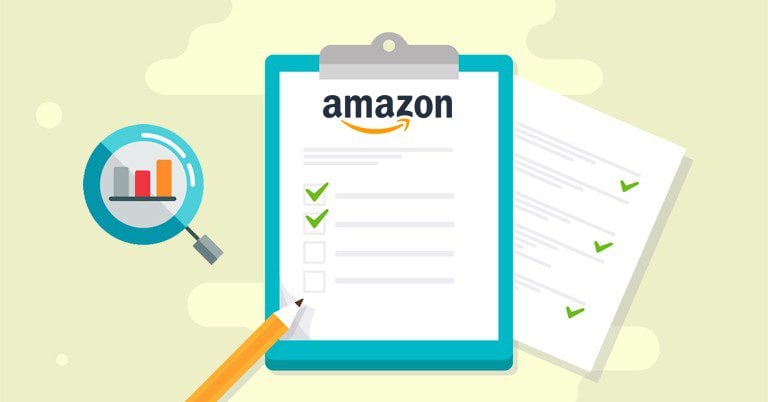Table of Contents
- 1 What is Amazon Competitor Analysis?
- 2 Why Should You Conduct Competitor Research?
- 3 What are the pros of conducting an Amazon competitor analysis?
- 4 How to identify your competitors for a good competitor profile analysis of Amazon?
- 5 6 steps to conduct Amazon competitor analysis
- 6 How To Use the Information You Have Gathered after Competitor Analysis?
- 6.1 1. Audit Your Competitors’ Listings
- 6.2 2. Monitor Competitor Pricing
- 6.3 3. Track Your Competitor’s Monthly Sales
- 6.4 4. Explore How Your Competition Markets Their Products
- 6.5 5. Create or Find the Right Goods to Sell
- 6.6 6. Price Your Items Appropriately
- 6.7 7. Optimize the Keyword Strategy
- 6.8 Steps to Optimize Your Keywords:
- 6.9 8. Broaden Your Business Outside the Amazon Marketplace
- 7 Conclusion
 Doing an analysis of the competition is a really useful strategy to help you succeed on Amazon. However, a proper Amazon competitor analysis would require certain tips, so you can properly pull it off.
Doing an analysis of the competition is a really useful strategy to help you succeed on Amazon. However, a proper Amazon competitor analysis would require certain tips, so you can properly pull it off.
To make your money grow on Amazon, you have to think carefully about your strategies. Regardless if you’re new in the business or already settled, knowing how to do Amazon competitors analysis is essential.
In this article, we’ll try to give you the answers to the following questions to keep you on top of your game:
- Are the items what they really seem to be based on their appearance?
- How strong are your competitors?
- What are the actions you should take?
What is Amazon Competitor Analysis?
Amazon seller competitor analysis is the process of examining rival sellers on the platform to understand their strengths, weaknesses, and strategies. This involves conducting Amazon product research, assessing competitor trends, and using competitive analysis tools to identify opportunities for improvement. The goal is to gather insights into pricing, product listings, advertising tactics, and customer feedback patterns to refine your own strategy and gain a competitive edge.
By leveraging best tools for Amazon analysis, sellers can track seller performance metrics, analyze Amazon keyword usage, and monitor competitor sales monitoring trends. This analysis helps sellers make data-driven decisions about product pricing, inventory management, and marketing strategies.
Why is Competitor Analysis Important?
Competitive analysis is a critical business practice on Amazon for several reasons:
- Identify profitable niches through Amazon niche analysis.
- Enhance customer experience by better understanding competitors’ strengths and weaknesses through customer reviews analysis.
- Discover marketplace competition trends, enabling informed decisions.
- Learn the pricing strategies for Amazon sellers to set competitive yet profitable prices.
- Gain insights into product listing strategies and how competitors optimize for visibility.
The data gathered from competitor trends and Amazon business insights can help make informed decisions, improve product offerings, and maximize return on investment.
Why Should You Conduct Competitor Research?
Conducting Amazon market analysis provides sellers with valuable insights into the competitive landscape. Below are key reasons why Amazon FBA competitor analysis is crucial for success:
- Identify market gaps: By conducting Amazon niche analysis, sellers can uncover underserved product categories and capitalize on unmet demand.
- Optimize pricing strategies for Amazon sellers: Studying Amazon pricing models helps in setting competitive prices to attract more buyers while maximizing profit margins.
- Improve product listings: Analyzing competitor product research reveals best practices in product listing strategies to enhance conversions.
- Refine marketing tactics: Understanding competitor advertising analysis provides insights into effective Amazon ad campaigns that drive traffic and sales.
- Enhance fulfillment methods: By performing a fulfillment methods comparison, sellers can determine whether Fulfillment by Amazon (FBA) evaluation or Fulfilled by Merchant (FBM) is the best option.
By continuously tracking marketplace competition, sellers can stay ahead of the competition and adapt to changing trends in the industry.

What are the pros of conducting an Amazon competitor analysis?
An Amazon FBA competitor analysis may feel like an enduring task. Should you really do it? Will you benefit from it? The short answer is, “yes!”
Discovering the competitive advantage of your competitors will provide you with a chance to:
- Make sure that your short-term pricing strategy is efficient
- Gather insights into delivering your message to make your good greatly stand out from others
- Opt for accurate sourcing in your item portfolio
- Keep track of performance and profitability
How to identify your competitors for a good competitor profile analysis of Amazon?
While working with product research for your business on Amazon, competition with other sellers who have similar options can turn into one of your biggest concerns. How to check what brands you are up against when you aren’t aware of who your major competitors are?
The simplest method to find your competitors is to look for your product keywords on Amazon. Begin with a broad query and check what pops up in the search engine results. The broader the search term is, the more harsh competition will be. However, as your niche gets more specific, the number of your direct competitors will lessen — and these are the ones you should concentrate on.
For instance, if you wish to sell a coffee machine, do the following. As you are probably aware, there exist various types of coffee makers in the market. You can have espresso makers, single-serve capsule machines, French press coffee makers, and so on — you get the point.
Imagine you need to sell a cold-brew coffee maker. To start with, search for the broadest term, “coffee maker,” to see what comes up.
Among the Amazon results, you will find a number of coffee machines to opt from. Basically, all of these products and brands would become your competitors. But your aim is to check niched-down long-tail keywords that will be more specific and relevant to your items.
Then, look for a “cold-brew coffee maker.” The search results you get show cold-brew coffee makes only — rather than 20 different kinds of coffee machines. The goods that appear in the Amazon search results from this particular search term are the main competitors you need to focus on.
Consider the first 10-20 items of the first results product page, as these products are sold by the high-performing competitors you should keep track of.

6 steps to conduct Amazon competitor analysis
Whether you like it or not, merchandise will always have one or more sellers, and that means more competition for you. This is when you need to have in-depth knowledge of competitor analysis.
For that reason, sellers should accurately source and explore smart actions for their investments, decide a competitive and profiting price for each of their products, make full use of their campaigns on advertising, and continually track the progress of their business encounters. The question is, how? Here’s the answer:
1. Check and review listings of products
For beginners, it’s best to keep a list of the products of your competitors. After that, make an online sheet that you can share with your team. Lastly, make a grading for every product listing feature such as product titles, descriptions, and pictures.
As much as possible, try to focus on the following areas:
- Product name – note that Amazon’s suggested product title format is “brand + model + product type.” Do a comparison between your competitor’s product title and yours. Moreover, think like the buyer when you are making your own title. You should keep it informative and never promotional.
- Product characteristics – this is what you should take a look at next. This is how you do a product feature competitive analysis: first is to check out the right of the items’ images, second is to take a careful look at your competitor’s emphasized USP (Unique Selling Point), and third is to think about how you could effectively counter this aspect.
- Product description – search for loopholes in your competitor’s descriptions. Did the seller forget some important information concerning their products? What information did he/she provide? How did he/she deliver his/her information? Is it just the usual format? Or is it reader-friendly?
- Q&A section – see if your opponents take measures in responding to their buyers’ questions. List all the common questions that shoppers ask, and answer these questions for yourself for your future listings.
- Product pictures – what product images are featured in the listing? Take a look at the quality. Could your team possibly remake the features of their product images, such as displaying the product functions, etc.?
2. Do a careful research
Learn from the tone and words used by other sellers in their product descriptions, Q&A, and features. Furthermore, understand how the images of their products were used, make detailed research on how to package your items, and how to label them. Most of all, remember to make an analysis of the content of the brand.
Set aside at least 20 minutes of your day to study the brands of your competitors. Who knows if your branding will be similar to your competitors or will be a completely different thing.
3. Keep an eye on reviews
To conduct an Amazon review analysis, check reviews with regard to their quality and quantity. Amazon desires that reviews have raw detail and substance. Therefore, scroll down through customer reviews and know the details concerning what users might have liked and disliked about a specific item. Also, check if reviews contain merely one sentence.
When it comes to reviews, quantity matters. Typically, the algorithms of Amazon favor items with both high-quality and high-quantity reviews.
Did your competitors receive many reviews for every product in comparison to your products? Moreover, always remember to check the score of each product on average. You can then contemplate your own strategy from the information you got.
4. Know the targeted keywords your competitors use
One of the most significant steps to do while doing your analysis is knowing what keywords your competitors use as part of their strategy. It ultimately depends on a careful review of your product listing.
Commonly, merchants place their main keyword on the title of the product. For example, “Organic Whole Bean Coffee” or “Organic Dark Roast Coffee” is the primary keyword used. Moreover, you can effortlessly search your competitor’s keywords by using any Amazon competitor analysis tool online.
5. Calculate the product prices and monthly sales of your competitors
It is a reality that the prices of your merchandise have a major effect on your sales. If your item’s price is more expensive than what another seller is selling it for, the tendency is that buyers will buy the cheaper one.
This is why evaluating the prices your competitors offer is an essential part of your competitor tracking template. Practically speaking, you do all these things for the sake of profit. So make sure you use the prices your competitors use as a reference and not as a benchmark.
Another way to keep your analysis on the upper hand is to calculate your competitor’s monthly sales. You can do this by estimating their gains through their monthly inventory. With all these at hand, your sales strategy will be effective, and with diligence, your sales will increase along with your profit.
6. Visit the shops of your competitors on Amazon
Some of your competitors may own an Amazon Store. Such a store is different for some companies that serve to provide customers easy access to the items they display and sell.
Therefore, if your competitor has one, better take a look at it and assess the following features:
- Arrangement – every company has its own design when it comes to the stores, though Amazon does provide standard templates. You can gain ideas on your competitor’s marketing strategy by looking at the game plan of their shop. To set an example, your competitor may emphasize some selected items on their storefront/homepage to inform their buyers of their bestsellers.
- Links to social media – shops on Amazon are allowed to have social media links. You can check the accounts of your competitors to help you and your team get some intelligence on what your competitor is actually primarily promoting.
So, what is the importance of all this information concerning competitive analysis?
With the growing number of competitors on Amazon, keeping an eye on your opponents will be your means of success. One of the most common mistakes that sellers on Amazon make is to purchase fiery products without trying to compete. Not facing competition will put your business on edge, so doing at least some research on the market will help you know who your “enemies” are. You will keep yourself on top of your competitors with even a little effort.
How To Use the Information You Have Gathered after Competitor Analysis?
1. Audit Your Competitors’ Listings
Analyzing Amazon product research involves assessing how competitors present their products. Analyzing Amazon product listings can highlight key areas for improvement.
Title Optimization
The product title is the first thing customers notice. Look at competing sellers to examine formatting, inclusion of relevant keywords, and any other identifiable trends. Use competitive marketplace insights to craft titles that are both captivating and SEO-optimized.
- Ensure the product title is clear, descriptive, and includes primary keywords.
- Study how competitors structure their titles for clarity and relevance.
- Compare competitor marketing tactics and identify best practices.
Images
High-quality images are paramount for conversions. Conduct Amazon seller comparison to evaluate your competitors’ image quantity, clarity, and use of infographics. Replicate these best practices to improve your visual appeal.
- High-quality images improve click-through rates and conversions.
- Compare competitors’ product images and implement improvements.
- Ensure compliance with Amazon’s image guidelines.
Bullet Points and Description
Your listing bullets and descriptions should highlight competitive benefits and key features. Use competitor insights and tools like AMZScout to identify the gaps you’re not addressing in your content.
- Use competitive marketplace insights to structure bullet points effectively.
- Highlight key benefits and features in a scannable format.
- Incorporate Amazon keyword usage for better search rankings.
Reviews
Customer feedback patterns, collected via tools like SageMailer can reveal crucial improvement areas like product durability, packaging, and shipping.
- Conduct customer reviews analysis to understand common praises and complaints.
- Address frequent pain points in your product description and customer service.
- Leverage reviewing competitor ratings to identify areas where your product can stand out.
2. Monitor Competitor Pricing
Adopt pricing strategies for Amazon sellers that are informed by competitor trends and customer expectations. Use tools like SellerSonar to dynamically adjust your pricing as the market fluctuates. Incorporate competitive pricing on Amazon to stay ahead while maintaining profitability. . Implementing competitive pricing on Amazon is key to remaining competitive. Sellers should analyze:
- Competitor pricing trends over time.
- How discounts and promotions affect sales.
- The impact of sponsored product ads review on pricing strategies.
- Adjust pricing dynamically based on market demand and competitor activity.
3. Track Your Competitor’s Monthly Sales
Monitoring your competitors’ sales volume helps you understand demand fluctuations and spot opportunities. Use competitive analysis tools like SellerSonar to track trends and predict sales potential. Tracking seller performance metrics helps in understanding:
- Sales trends and fluctuations in demand.
- Impact of seasonal changes on competitor sales.
- The effectiveness of different pricing strategies for Amazon sellers.
- Market saturation and identifying potential gaps.
Using best tools for Amazon analysis, sellers can make informed decisions on inventory levels and marketing efforts.
4. Explore How Your Competition Markets Their Products
Conduct a competitor advertising analysis by reviewing your competitors’ strategies in Amazon ad campaigns. Study their use of sponsored product ads review to refine your promotional activities. Tools can help you identify which keywords to focus on when running ads. Effective Amazon marketing strategies involve analyzing competitor campaigns:
- Sponsored product ads review for ad placement and effectiveness.
- Competitor marketing tactics like social media promotions and influencer collaborations.
- Keyword optimization strategies in advertising campaigns.
- Organic vs. paid traffic distribution and performance.
By understanding Amazon business insights, sellers can fine-tune their own marketing efforts to drive better results.
5. Create or Find the Right Goods to Sell
The first step in Amazon market analysis is identifying the right products to sell. Conducting thorough Amazon niche analysis allows sellers to find high-demand, low-competition products.
Steps to Identify Profitable Products:
- Conduct Amazon Product Research – Use tools like AMZScout, SellerSonar, Jungle Scout, or Helium 10 to analyze sales volume, competition, and demand trends.
- Review Competitor Sales Monitoring Data – Look at top-selling products in your niche and analyze their sales performance over time.
- Check Customer Reviews Analysis – Identify common complaints and gaps in existing products to create a better offering.
- Analyze Competitor Product Research – Compare features, pricing, and fulfillment methods to assess product feasibility.
By leveraging competitive marketplace insights, sellers can position their products strategically and enhance their seller performance metrics.
6. Price Your Items Appropriately
Pricing is a key factor in Amazon seller comparison and determines a product’s competitiveness. Using the right pricing strategies for Amazon sellers ensures a balance between profitability and sales volume.
Effective Pricing Strategies:
- Cost-Plus Pricing: Calculate the cost of goods and add a markup.
- Competitive Pricing on Amazon: Monitor competitor pricing models and adjust accordingly.
- Dynamic Pricing: Use pricing tools like RepricerExpress to automatically adjust prices based on competition.
- Psychological Pricing: Use charm pricing (e.g., $19.99 instead of $20) to attract buyers.
By tracking competitor sales monitoring data, sellers can optimize their pricing model and remain competitive in the marketplace.
7. Optimize the Keyword Strategy
A well-optimized keyword strategy improves product visibility and ranking in Amazon search results. Amazon keyword usage should be strategic, targeting both high-traffic and long-tail keywords.
Steps to Optimize Your Keywords:
- Competitor Keyword Analysis: Use tools like Reverse ASIN Lookup to analyze competitor marketing tactics.
- Use High-Performance Keywords: Incorporate keywords with high search volume into product titles and descriptions.
- Leverage Backend Keywords: Utilize hidden backend keywords to increase discoverability.
- Monitor and Adjust: Regularly track keyword performance and refine the strategy.
By implementing a strong keyword strategy, sellers can boost improving seller rankings and increase organic traffic.
8. Broaden Your Business Outside the Amazon Marketplace
Expanding beyond Amazon can help sellers diversify their revenue streams and reduce dependency on a single marketplace.
Strategies for Expansion:
- Create a Branded Website: Use Shopify or WooCommerce to establish an independent eCommerce presence.
- Leverage Social Media: Engage customers through Instagram, Facebook, and TikTok marketing.
- Sell on Other Marketplaces: Expand to Walmart, eBay, or Etsy to reach a broader audience.
- Utilize Email Marketing: Build an email list for direct customer engagement.
By expanding beyond Amazon, sellers can enhance their Amazon seller optimization and build a sustainable eCommerce business.
Conclusion
Conducting a competitor analysis will keep you accurately informed about what are the wise decisions to make concerning your business. With this, you will also be able to decide on the strategy for the pricing you will use. By researching different promotional and advertising strategies, you will get more ideas with regard to how you can optimize your own campaigns.
With the SageMailer program, you will achieve more organic testimonials and master Amazon. So what exactly does it provide to you? In the main, you get a boost in sales in comparison with your competitors. With it, you can:
- track sales metrics;
- enhance client activity by encouraging them to write reviews;
- send messages to customers;
- get notifications on your devices once a user shares a testimonial;
- reply to shoppers with ready-made templates.
To sum up, SageMailer can help to increase the sales of your goods products and build trust with your Amazon clients. Subscribe now and enjoy our free 30-day trial.


